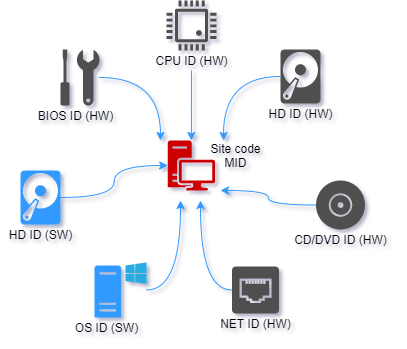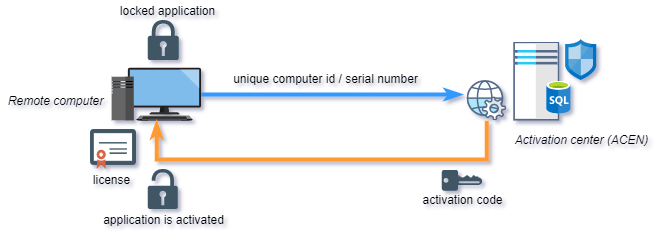Machine locking
Machine locking is the process of locking (linking) protected application to remote computer in order to prevent illegal usage on multiple computers. There are seven different locking parameters (locks) that can be enabled or disabled. Two of these are software locks (HD ID, OS ID) and five are hardware (HD ID (HW), CD/DVD, NET ID, CPU ID and BIOS ID) locks.

Site/MID codes are based on enabled locks and application signature value. Application signature uniquely identifies project files and thus protected application on remote computer.
Each lock can be marked as mandatory. If lock is marked as mandatory and if protection code is not able to obtain such lock on remote computer appropriate error message will be displayed to end user.
By default, change in any of selected locks will result in license reset. Application will erase current license, change site/mid codes and request new activation code. This default behavior can be customized with flexible licensing feature. If 'Changeable' flag is not selected, protection code will not allow changes for appropriate locking parameter. This is default behavior. If selected, protection code will allow changes for locking parameter.
If multiple hardware locking parameters are marked as changeable, protection code will not reset license as long as total number of changes is lower than defined maximum number of allowed hardware changes.
Use Machine ID decoding feature (in activation panel) to obtain each lock value from remote computer. In this way you can easily compare old and new locking parameters and thus prevent false requests for new activation codes.
Activation
Effective machine locking requires software activation process. Software activation represents exchange of keys (activation codes) between you and your end users.

End user would submit his Site/MID codes (unique computer id) to you and you would provide appropriate valid activation code based on these codes back to end user. User can than activate his application on remote computer with provided activation code. If moved to another computer, protected application will generate different Site/MID codes and require new (different) activation code.
By default, Internet connection is not required for activation. Protected application can be securely activated even by phone, fax or e-mail. Activation process can also be fully automated with the help of Activation center:
